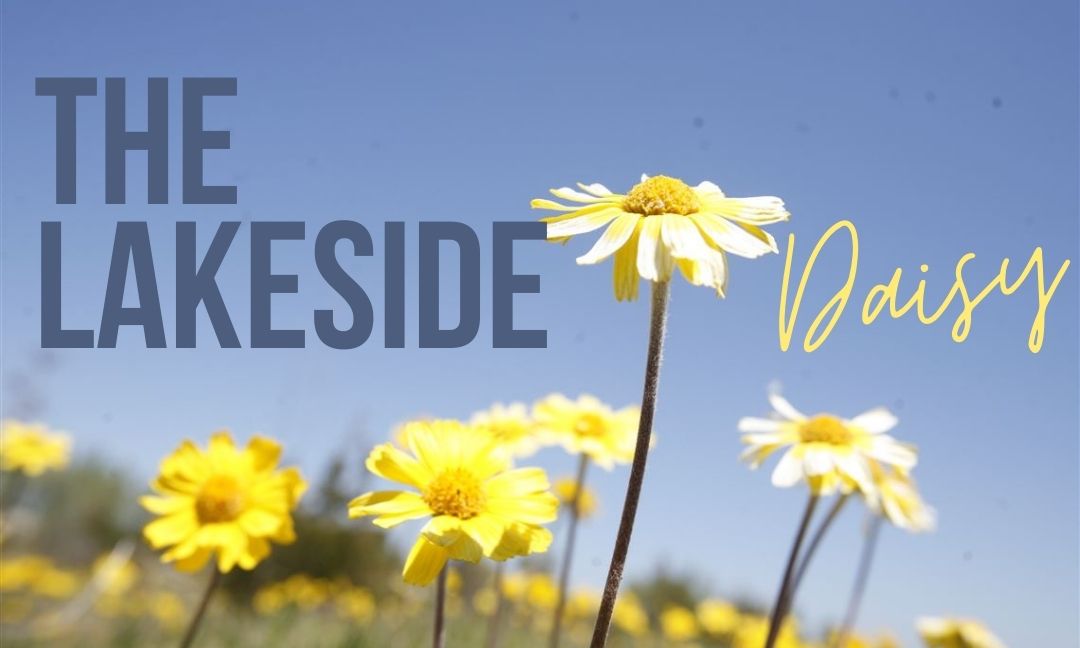Author: Reva Grewal
Editor: Connor Fraser
Featured Image Designer: Emily Sheng
Publisher: Jumana Ismail
Many know of a flower’s beauty. From the symmetry to colour and scent, most people can appreciate its presence. Some may dream of lying in a fluffy flower bed, while others are allergic to pollen. Either way, it is easy to admire flowers.
However, some of these beautiful flowers are threatened. One such flower is the Lakeside Daisy; the subject of today’s plant spotlight. It may not seem like much but like everything in an ecosystem, it serves a purpose. This post will examine the characteristics of the Lakeside Daisy, the importance of this daisy, and why it is endangered.

Lakeside Daisy (Fyon, n.d)
The Lakeside Daisy can be described as a yellow/gold flower that opens face-up. It has a centre that displays yellow and golden florets and has petals that have slight cuts in them, almost as if they were teeth. Its scientific name is Tetraneuris herbacea, from the family Astereae (United States Department of Agriculture, 2021). The Astereae family encompasses sunflowers, asters, daisies, and composites (Tropicos, 2021). Admittedly, the Lakeside Daisy resembles the common and pesky dandelions. However, the Lakeside Daisy has petals that are thicker and more defined. Dandelions also lack gold/yellow florets and are much more common than Lakeside Daisies. The Tetraneuris herbacea grows up to 35 cm in height (slightly more than the size of a ruler). Unlike their petals, the green leaves at their stems are toothless. This gorgeous Daisy can be found in the Great Lakes region, Ohio, Illinois, Michigan, and Southern Ontario, amongst other locations. What is special about this flower is that it is rare across the world but can be found commonly in certain areas of Ontario (Government of Ontario, 2021). The map detailing its location will be shown below. In terms of particular environments, Lakeside Daisies love alvars. Alvars are open areas with a thin amount of soil or limestone. As the name implies, they enjoy growing near bodies of water. Despite its threatened status, it is quite adaptable. They can survive flooding, droughts, and hot temperatures (52°C) because of their love of alvars. Alvars provide an extreme environment, as a large part of them are slits in rocks that can support plants with little soil (Batten, 2018). Even such a seemingly delicate creature proves to be powerful and overcomes adversity.
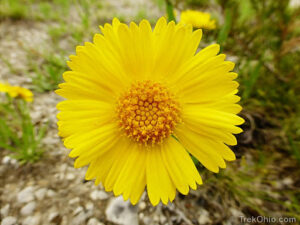
Lakeside Daisy (TrekOhio, n.d)
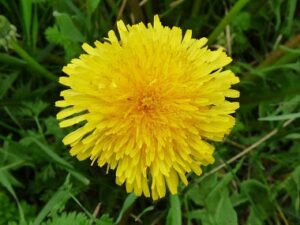 Dandelion (In Edible Wild Food, n.d)
Dandelion (In Edible Wild Food, n.d)
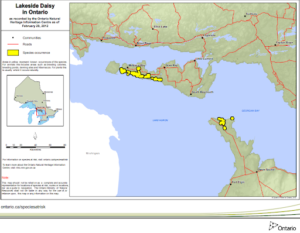
Map of lakeside daisy locations (Lakeside Daisy in Ontario, 2012)
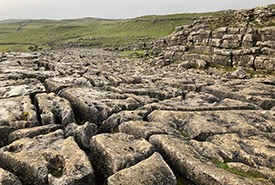
Alvar (Batten, 2018)
Although quite unassuming, the Lakeside Daisy supports many. A variety of animals – whether it be birds, insects, or mammals, eat the Lakeside Daisy. To be more specific, deer and rabbits adore eating daisies (Sanders, 2020). Its thick and rubbery leaves allow it to store water for consumption (Government of Ontario, 2021). Moreover, the Lakeside Daisy provides opportunities for pollinators, as it is a flowering plant. They are also considered more appealing to prospective pollinators such as bees because of their open shape (Government of Ontario, 2011). Speaking generally, some daisies have usable medicinal properties. People use over-the-counter wild Daisy for treating ailments such as coughs, bronchitis, kidney and liver inflammation (WebMD, n.d). This is not a medical recommendation but a practice some may choose to partake in with their discretion. The Wild Daisy has a chemical called saponin, which helps to produce collagen in the cells, which is how it is used to help treat the ailments I listed earlier (WebMD, n.d). Certain daisies are also edible. They can be seen as an addition to salads but it is not recommended to eat without confirming that particular species is edible. In addition, Daisies have symbolic meanings such as innocence or purity (Stanton, 2021).
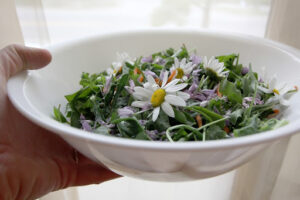
Daisy Salad (Davis, 2015)
So what is endangering this magnificent creature? In short, Lakeside Daisies are currently being threatened with habitat loss and by invasive species. This is in conjunction with being trampled by humans, as they are often featured on popular hiking trails in certain areas (Batten, 2018). More specifically, logging, creating quarries, off-road vehicles, cottage construction, camping, climate stresses, and fire suppression are specific contributing factors to this species’ decline. As this Daisy resides in a rare habitat, its preservation is even more important (Government of Canada, 2011). Do not fret, however! The government of Ontario is taking steps to preserve this flower. They announced a firm action plan in 2014 that outlines steps to save the Lakeside Daisy (Government of Ontario, 2021).
To conclude, the Lakeside Daisy is an endangered species. Although it is resilient, it cannot keep up with the human-created problems, as it was not designed to adapt to those affairs. Through its beauty and grace, it can bring joy to many. With adequate efforts it can be preserved and saved. At the end of the day, Daisies are important, whether it be through food for us or food for wild creatures, or even medicine, Daisies serve a purpose.
References
Andrews, S. (2020, January 31). Edible Flowers: Garden and Wild Flowers You Can Eat. Delishably.
https://delishably.com/foraging/Edible-Flowers-garden-and-wild-flowers-you-can-eat
Batten, E. (2018a, April 18). Alvar explorations of a wandering biologist (part one). www.natureconservancy.ca.
https://www.natureconservancy.ca/en/blog/archive/alvar-explorations.html
Batten, E. (2018). Alvar in Malham Cove, U.K. In Nature Conservancy Canada.
https://www.natureconservancy.ca/en/blog/archive/alvar-explorations.html
Davis, E. (2015). daisy-salad-sm. In Wild Food Girl.
https://wildfoodgirl.com/2015/a-tale-of-four-daisies/daisy-salad-sm/
Fyon, A. (n.d.). Lakeside Daisy. In CC BY-NC 4.0. Retrieved October 2, 2021, from
Government of Canada. (2011, November 29). Species Profile (Lakeside Daisy) – Species at Risk Public Registry. Wildlife-Species.canada.ca.
https://wildlife-species.canada.ca/species-risk-registry/species/speciesDetails_e.cfm?sid=705
Government of Ontario. (2021, August 12). Lakeside daisy. Ontario.ca.
https://www.ontario.ca/page/lakeside-daisy
Lakeside Daisy in Ontario. (2012). In Government of Ontario.
https://www.ontario.ca/page/lakeside-daisy
Sanders, A. (2020, September 3). What eats a Daisy? Garden Guides. Retrieved October 13, 2021, from
https://www.gardenguides.com/12584311-what-eats-a-daisy.html.
Stanton, K. (2021, May 30). Daisy Flower Meaning, Symbolism & Mythology [+ Aster Flowers]. UniGuide.
https://www.uniguide.com/daisy-flower-meaning-symbolism-aster/
TrekOhio. (n.d.). A macro photo of Lakeside Daisy. Retrieved October 2, 2021, from
https://trekohio.com/2013/05/12/lakeside-daisy-state-nature-preserve/
Tropicos. (2021, October 2). Tropicos | Name – !!Asteraceae Bercht. & J. Presl. Legacy.tropicos.org. http://legacy.tropicos.org/Name/50307371?projectid=0
United States Department of Agriculture. (2021 9). Tetraneuris herbacea Greene GRIN-Global. Npgsweb.ars-Grin.gov. https://npgsweb.ars-grin.gov/gringlobal/taxon/taxonomydetail?id=401096
WebMD. (n.d.). Wild Daisy: Uses, Side Effects, Interactions, Dosage, and Warning. www.webmd.com. Retrieved October 2, 2021, from https://www.webmd.com/vitamins/ai/ingredientmono-9/wild-daisy#:~:text=People%20take%20wild%20daisy%20tea
(n.d.). In Edible Wild Food. Retrieved October 2, 2021, from https://www.ediblewildfood.com/dandelion.aspx

